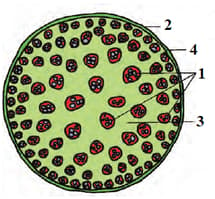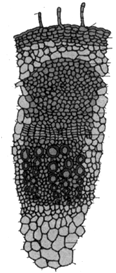In a typical dicot plant, the vascular cambium of roots differs from the vascular cambium of stems in
Important Questions on Morphology and Modifications
Identify the labelled parts in the below figure.

Read the following statements about the vascular bundles:
(a) In roots, xylem and phloem in a vascular bundle are arranged in an alternate manner along the different radii.
(b) Conjoint closed vascular bundles do not possess cambium.
(c) In open vascular bundles, cambium is present in between xylem and phloem.
(d) The vascular bundles of dicotyledonous stem possess endarch protoxylem.
(e) In monocotyledonous root, usually there are more than six xylem bundles present.
Choose the correct answer from the options given below :
The transverse section of a plant shows following anatomical features:
(a) Large number of scattered vascular bundles surrounded by bundle sheath
(b) Large conspicuous parenchymatous ground tissue
(c) Vascular bundles conjoint and closed
(d) Phloem parenchyma absent
Identify the category of plant and its part:
Identify group of plants based on given anatomical characters in sequence.
Bicollateral vascular bundles
Bulliform cells
Ring arrangement of vascular bundles
Answers respectively
Select the incorrect option with respect to the given anatomy of the plant part.

Represent the union of two sets by Venn diagram for each of the following.
is a prime number between and
is an odd number between and
Read the following statements with respect to dicot stem and select the right choice.
i. The epidermis is covered with a thick layer of cuticle.
ii. The cells of endodermis are rich in starch grains.
iii. The pericycle is present on the inner side of endodermis and above the phloem in the form of semilunar patches of sclerenchyma.
iv. The vascular bundles are arranged in a ring.
Read the following statements with respect to the dicot stem and select the correct option.
(a) Epidermis is covered with a thin layer of cuticle, may bear trichomes, and a few stomata.
(b) Ring arrangement of conjoint, collateral, and open vascular bundles.
(c) Presence of semilunar patches of sclerenchyma above the phloem.
(d) Presence of conjunctive tissue between the xylem and the phloem.

